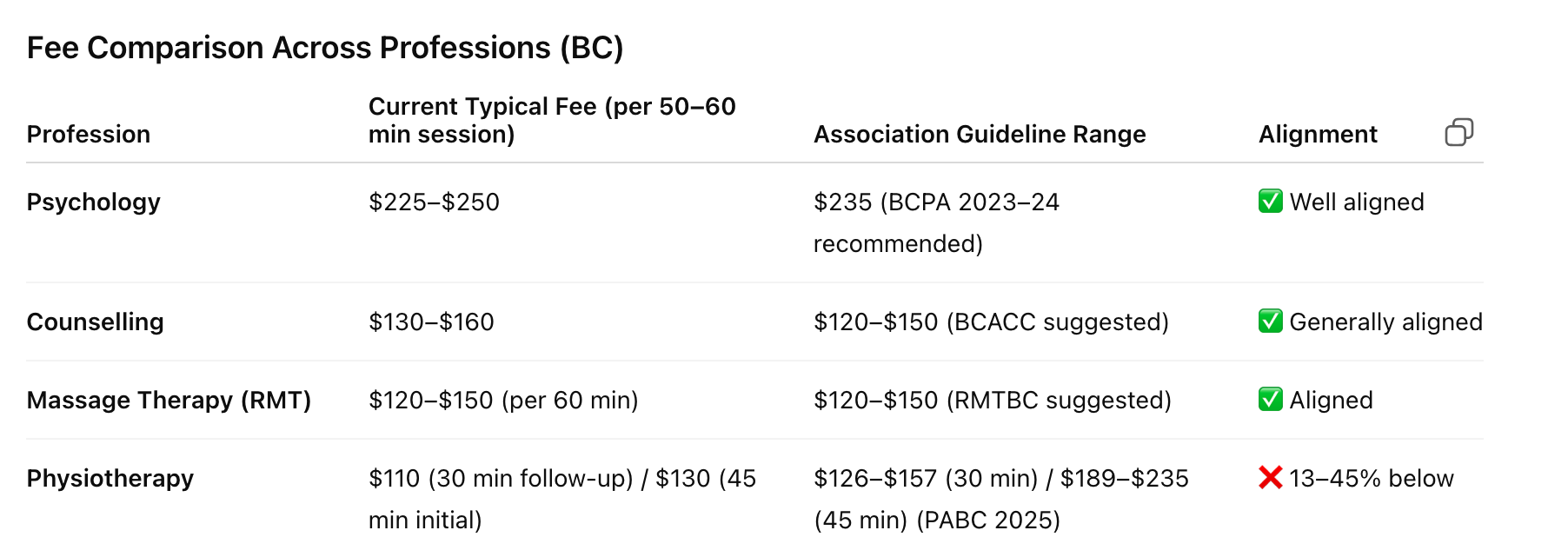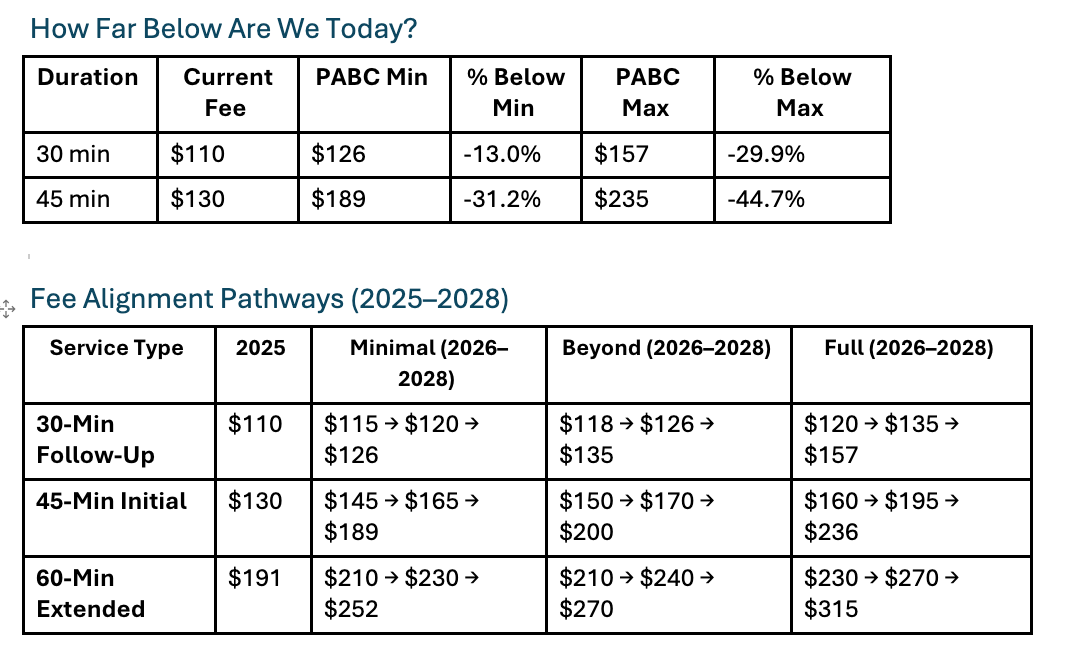Empty space, drag to resize
A few months ago, I was working with folks at the PABC to raise the issue of our MSP model — where the fee, income brackets, and number of visits haven’t been updated in 23 years. Yes, twenty-three years. (I wrote about that in a previous
Friday 5 if you missed it).
That rabbit hole got me curious: what about physiotherapy fees in general? How do we compare to other professions? It turns out dentistry, psychology, counselling, and massage therapy have built a rhythm of reviewing and adjusting fees every year or two. Their associations send those updates to insurers, some insurers adjust reimbursement, and the profession keeps pace.
Physiotherapy, on the other hand, has been stuck pressing snooze to some extent. And the longer we wait, the harder it may be to catch up.

Here’s why this fee alignment conversation matters: many costs keep rising beyond inflation — rent, wages, software, insurance, groceries, cars, gas, subscriptions, etc. For many, clinics are trying to plan, grow and sustain quality practices in a world where the financial engine is sputtering, and clinicians are trying to build sustainable careers, plan for and enjoy life, and pay off student debt without burning out.
And yet, perspective matters. Things could be worse. In the US, physios have watched reimbursement rates decline year after year. Many are forced to see three to four patients an hour, or shift into the uncertainty of a cash-based model that can price out some parts of the population. Compared to that, Canadian physio is still in a relatively good spot. I don’t want to lose sight of this, and I really hope our US colleagues can change that trajectory.
But here’s the asymmetry in British Columbia: dentistry, psychology, counselling, massage — all have normalized steady, incremental updates, and those updates actually translate into changes at the clinic level. Physio hasn’t. We’ve received guidance, but we haven’t consistently acted on it. And over time, that difference compounds. Like two runners who start together, but one takes a few extra steps forward each year — a decade later, they’re nowhere near each other.
And we can see this in the numbers. Many current physio fees are 13–45% below PABC’s 2025 recommended rates. If another profession were that far behind, it would probably set off alarm bells right?
I crunched a few numbers which you can see below:

Now, to be fair: psychologists have PhD-level training and there are far fewer of them than physiotherapists. That scarcity and training intensity naturally push their fees higher — and that makes sense. But even professions with shorter training pathways, like counselling or massage therapy, have normalized fee updates. Physiotherapy hasn’t. So the point isn’t that we need to match psychology dollar-for-dollar — it’s that we need to stop undervaluing ourselves relative to our own benchmarks.

Fee alignment isn’t just about covering costs. It has ripple effects across businesses, clinicians, and clients. And to be clear, fixing fees doesn’t magically fix every challenge we face — the world is more complex than that. But it does set a healthier foundation, so we’re not trying to solve 2025 problems with 2015 price structures.
Here are a few pros and cons of going with the fee guidelines:
For businesses
✅ Protects margins as costs rise
✅ Creates room to reinvest in talent, people, education, innovation, etc.
❌ Risk of short-term client attrition if fees climb too fast
❌ Communication lift — more conversations with patients about “why”
For clinicians
✅ Affirms professional worth (“my time and training matter”)
✅ Opens up space for better wages and manageable caseloads
❌ Raises client expectations — if they’re paying more, maybe they expect more
❌ Perhaps current patient's can no longer afford the care.
For clients
✅ Reinforces that physiotherapy is high-value care, not a bargain-bin service
✅ Helps keep their clinician — better retention means better continuity
❌ Higher out-of-pocket costs if benefits don’t increase
❌ May limit visit frequency for those already near benefit caps
It’s not black-and-white. There are clear upsides — and very real risks. I haven't laid them all out here and I am sure you can think of many more. But the bigger question is why were are not aligned and whether staying under-aligned is truly safer.
I crunched more numbers below based on average private physiotherapy rates in the lower mainland and provided a few scenarios on how the profession might get aligned:


Ask yourself (or your team): What story does our fee structure tell?
Right now, psychology and counselling fees are aligned with their associations. What about physio fees? The unspoken story: “mental health deserves the going rate, physical rehab is a discount service.” That’s not one of the many stories we want clients, insurers, or clinicians hearing.
Behavioural economics gives us a few ways to look at this:
- Comparison bias 🔍 — people don’t evaluate prices in isolation, they compare them. If physio is way below psychology or massage, it looks undervalued by default.
- Price–quality heuristic 💎 — people may assume higher prices signal higher quality. When physio sits at the bottom of the chart, the message (fair or not) is that it’s less specialized or impactful.
- Anchoring effect ⚓ — once people are used to $110 as “the physio price,” it becomes their anchor. Any increase later feels steep, even if it’s still below other professions.
Here’s a simple way I think about it: I love a good glass of wine as many of you know 🍷. When I see a $12 bottle and a $40 bottle on a menu, my brain assumes the $40 must be better. Even if most people couldn’t tell the difference in a blind taste test, the price itself shapes perception. (Full disclosure: I’m enough of a wine snob that I probably could tell… or at least I’d convince myself I could.). Physio fees work the same way — if we keep ourselves priced like the $12 bottle, we shouldn’t be surprised if people assume the care is “less.”

Fee alignment is more than a financial adjustment — it’s also a good strategic positioning move.
For clients: Higher fees, paired with excellent care, reinforce trust. It’s premium signaling — people commit more deeply to care they’ve invested in. (Think: the difference between a YouTube workout and a personal trainer.)
For clinicians: Aligned fees create margin for mastery — fewer sessions per day, fairer pay, less burnout. That fuels retention and better outcomes.
For the profession: Alignment builds market discipline. When clinics move together, insurers can’t ignore it. Fragmentation doesn't put us in a great position.
For resilience: Low fees trap us on the volume treadmill. Alignment allows growth through sustainability, not overbooking.
Of course, raising fees isn’t a magic fix. Recruitment pressures, benefit caps, and access concerns don’t vanish overnight. But alignment is a lever we actually control — and it strengthens everything else.
👉 Don’t just take my word for it. Go poke around the fee guides yourself:
See how they line up. See how consistent they are. And then ask: why hasn’t physio built that same rhythm?

Fee alignment is advocacy. It’s not just about covering costs — it’s about shaping the future of physiotherapy.
- To insurers, it says: “we’re serious about fair value.”
- To clients, it says: “this is high-quality care worth investing in.”
- To clinicians, it says: “your time and expertise matter.”
When we freeze fees and forget to keep up with inflation, we aren’t just keeping things “affordable.” We’re anchoring the profession in place, while everyone else quietly moves ahead.
Alignment isn’t a silver bullet. But it is a signal — one that says physiotherapy is ready to step into the same rhythm as psychology, counselling, and massage, and claim the value it deserves.
We’ve lived the consequences of frozen rates before (hello, 23 years of MSP stagnation). Let’s not repeat that mistake in a different form. Fee alignment won’t solve everything — but it does give us a stronger foundation to work from.
I’d love to hear what you think — the hopes, the worries, your disagreements, and pointing out the blind spots I have. If you want to share your perspective (anonymously), you can drop your
feedback here.







